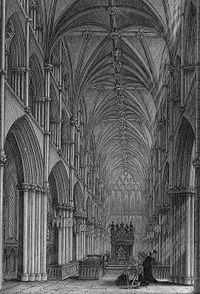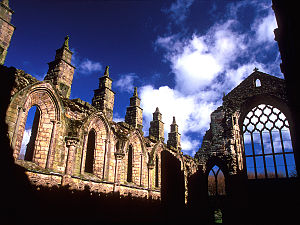- Holyrood Abbey
-
For the Church of Scotland congregation, see Holyrood Abbey Church.
Holyrood Abbey is a ruined abbey of the Canons Regular in Edinburgh, Scotland. The abbey was founded in 1128 by King David I of Scotland. During the 15th century, the abbey guesthouse was developed into a royal residence, and after the Scottish Reformation the Palace of Holyroodhouse was expanded further. The abbey church was used as a parish church until the 17th century, and has been ruined since the 18th century. The remaining walls of the abbey lie adjacent to the palace, at the eastern end of Edinburgh's Royal Mile. The site of the abbey is protected as a scheduled monument.[1]
Contents
Etymology of name
Rood is an old word for a type of Christian cross, bearing a lower cross-bar as well as the main upper cross-bar. It therefore means the cross which Jesus Christ was crucified upon; thus the name Holyrood is equivalent to "Holy Cross."
History


The Chapel Royal at the time of James VII.[2] Legend relates that in 1127, while King David I was hunting in the forests to the east of Edinburgh during the Feast of the Cross, he was thrown from his horse after it had been startled by a hart. According to variations of the story, the king was saved from being gored by the charging animal when it was startled either by the miraculous appearance of a holy cross descending from the skies, or by sunlight reflected from a crucifix which suddenly appeared between the hart's antlers while the king attempted to grasp them in self-defence. As an act of thanksgiving for his escape, David I founded Holyrood Abbey on the site in 1128.[3] The abbey was originally served by a community of Augustinian Canons Regular from Merton Priory. The layout of the abbey is clearly based on that building.[3] In 1177 the papal legate Vivian held council here. In 1189 the nobles and prelates of Scotland met here to discuss raising a ransom for William the Lion.[3]
The original abbey church of Holyrood was largely reconstructed between 1195 and 1230.[3] The completed building consisted of a six-bay aisled choir, three-bay transepts with a central tower above, and an eight-bay aisled nave with twin towers at its west front.[4]
The Parliament of Scotland met at the abbey in 1256, 1285, 1327, 1366, 1384, 1389 and 1410. In 1326 Robert the Bruce held parliament here and was certainly using the building as a royal palace at or before 1329.[3] The Treaty of Edinburgh–Northampton (1328), which brought an end to the First War of Scottish Independence, was signed by Robert I in the "King's Chamber" at Holyrood in March 1328. The abbey's position close to Edinburgh Castle meant that it was often visited by Scotland's kings, who were lodged in the guest house situated to the west of the abbey cloister. In the mid-15th century, with the emergence of Edinburgh as the main seat of the royal court and the chief city in the kingdom, the Kings of Scots increasingly used the accommodation at Holyrood for secular purposes. James II and his twin brother Alexander, Duke of Rothesay were born there in October 1430. James was also crowned at Holyrood in 1437 and building works were carried out before his marriage there in 1449.[5][6] Between 1498 and 1501, James IV constructed a royal palace at Holyrood, adjacent to the abbey cloister. Royal influence over the abbey further increased when in 1538 Robert Stewart, the infant, illegitimate son of James V, was appointed as commendator of Holyrood.[7][8]
During the War of the Rough Wooing, the invading English armies of the Earl of Hertford inflicted structural damage on Holyrood Abbey in 1544 and 1547. Lead was stripped from the roof, the bells were removed, and the contents of the abbey were plundered. In 1559, during the Scottish Reformation, the abbey suffered further damage when a mob destroyed the altars and looted the rest of the church.[9] With the reformation and the end of monastic services, the east end of the abbey church became redundant. In 1569, Adam Bothwell, the commendator of Holyrood, informed the General Assembly of the Church of Scotland that the east end was in such a state of disrepair that the choir and transept should be demolished. This was done the following year, retaining only the nave, which by then was serving as the parish church of the burgh of Canongate. Between 1570 and 1573 an east gable was erected, closing the east end of the former nave, all but two of the windows in the nave were blocked up, the royal tombs were removed to a new royal burial vault in the south aisle and the old east end was demolished.[10] The abbey was extensively remodelled in 1633 for the coronation of Charles I.
In 1686, James VII established a Jesuit college at Holyrood. The following year, the Protestant congregation was moved to the new Kirk of the Canongate, and the abbey was converted into a Roman Catholic Chapel Royal and the chapel of the Order of the Thistle.[11] The abbey church was remodelled according to the plans of James Smith, and was fitted with elaborate thrones and stalls for the individual Knights of the Thistle, carved by Grinling Gibbons. However in 1688, following the Glorious Revolution, the Edinburgh mob broke into the abbey, destroyed the Chapel Royal and desecrated the royal tombs.[12][13] The roof was vaulted in stone in 1758, but the work was badly executed, and during a storm in 1768 the roof collapsed, leaving the abbey as it currently stands, a roofless ruin. The restoration of the abbey has been proposed several times since the 18th century - in 1835 by the architect James Gillespie Graham as a meeting place for the General Assembly of the Church of Scotland and, in 1906, as a chapel for the Knights of the Thistle — but both proposals were rejected.[14]
Coronations
Holyrood Abbey was the site of the coronations of James II in 1437 and Charles I in 1633. Queens consort who were crowned at Holyrood include:
- Margaret Tudor in 1504
- Mary of Guise in 1540
- Anne of Denmark in 1590
Weddings
The abbey was the site of numerous royal weddings. These include:
- James II and Mary of Guelders in 1449
- James III and Margaret of Denmark in 1469
- James IV and Margaret Tudor in 1503
Births
- James II was born here in 1430
Burials
The abbey was the site of many royal funerals and interments, mostly in the east bay of the south aisle, known as the "Royal Vault". Royals originally interred here include:
- King David II in 1371
- King James II in 1460
- Arthur, Duke of Rothesay (second son of James IV) in 1510
- Madeleine of Valois in 1537
- James, Duke of Rothesay (eldest son of James V) in 1541
- Arthur, Duke of Albany (second son of James V) in 1541
- King James V in 1542
- Henry Stuart, Lord Darnley in 1567
- Margaret (second daughter of James VI) in 1600
- Mary of Guelders in 1848 (Mary was originally buried in Trinity College Kirk)
Non-royal interments/monuments of note include:
- Alexander Mylne d.1643, master mason. Monument restored by his descendant Robert Mylne in 1776.
- Robert Douglas, Viscount Belhaven d.1639. Recumbent marble statue by John Schoerman very similar to another work by Schoerman in Westminster Abbey.
- Medieval slab c.1300 to Sibilla de Stratun (presumably what is now Straiton).
- Medieval coffin to Robert Ross d.1409, incised with a chalice.
- Bishop George Wishart d.1671. Headless cherubs on the pediment, seemingly by Robert Mylne.
- George, Earl of Sutherland, d.1703, Monument by James Smith, including coroneted family names on the columns.
- Jane, Countess of Eglinton, d.1596. A tomb-chest form similar to others in Greyfriars Kirkyard.
- Thomas Lowes d.1812
- Adam Bothwell d.1593.
- Margaret Bakster (the old spelling of Baxter) d.1592
- Adjacent to the above an illegible monument to John (?) d.1543 with cross, compasses and tools.
- Euphemia Stewart d.1817, an obelisk bracketed out of the wall.
- George Douglas, Bishop of Moray (
See also
- Abbeys and priories in Scotland
- Abbot of Holyrood, for a list of abbots and commendators
- Kirk of the Canongate
Notes
- ^ "Holyrood Abbey and Palace gardens". Historic Scotland. http://data.historic-scotland.gov.uk/pls/htmldb/f?p=2300:35:4237007650032168::NO::P35_SELECTED_MONUMENT:10805. Retrieved 2011-03-31.
- ^ Daniel, William S. (1852), History of the Abbey and Palace of Holyrood. Edinburgh : Duncan Anderson. facing p. 129.
- ^ a b c d e McWilliam, Colin; Gifford, John; Walker, David (1984). Edinburgh. The Buildings of Scotland. Penguin. ISBN 014071068.
- ^ Fawcett, p.62
- ^ Gallacher, p.1079.
- ^ Fawcett, p.62.
- ^ Fawcett, p.62
- ^ Gallacher, p.1080.
- ^ Gallacher, p.1084.
- ^ Gallacher, p.1084.
- ^ Burnett and Bennett. p.7.
- ^ Burnett and Bennett. p.7.
- ^ Gallacher, p.1085.
- ^ Gallacher, p.1085.
References
- Burnett, Charles and Bennett, Helen, The Green Mantle: a celebration of the revival in 1687 of the Most Ancient and Most Noble Order of the Thistle, Edinburgh, 1987.
- Fawcett, Richard, The Palace of Holyroodhouse: official guide, HMSO, Edinburgh, 1988.
- Gallagher, Dennis, "Holyrood Abbey: the disappearance of a monastery", in the Proceedings of the Society of Antiquaries of Scotland, 128 (1998), pp. 1079–1099.
External links
- Holyrood Abbey - site information from Historic Scotland
- Catholic Encyclopedia's article on the abbey
- Holyrood Abbey Church website
Coordinates: 55°57′11.38″N 3°10′17.67″W / 55.9531611°N 3.171575°W
Categories:- Historic Scotland properties
- 1120s architecture
- Category A listed buildings in Scotland
- Church of Scotland churches
- Churches in Edinburgh
- Augustinian monasteries in Scotland
- Listed buildings in Edinburgh
- Listed monasteries in Scotland
- Scheduled Ancient Monuments in Scotland
- 1128 establishments
- Religious organizations established in the 1120s
- Royal Mile
- Christian monasteries established in the 12th century
- Canons Regular
- Coronation church buildings
Wikimedia Foundation. 2010.


